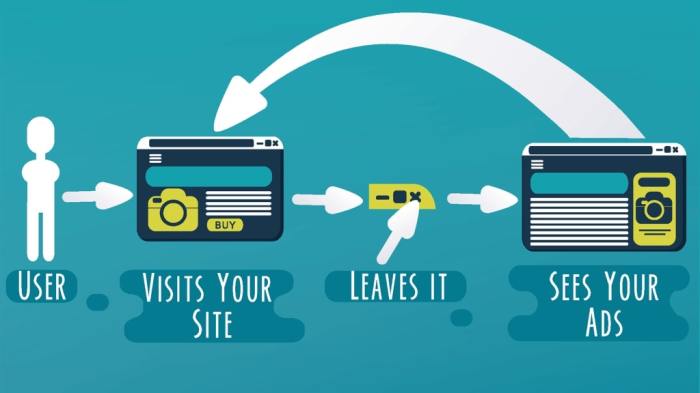Retargeting Strategies for E-commerce takes center stage, drawing you into a world of savvy marketing tactics and game-changing insights. Get ready to dive deep into the realm of online business success with a touch of hip flair.
Explore the various types of strategies, implementation steps, and success metrics that can elevate your e-commerce game to new heights.
Overview of Retargeting Strategies for E-commerce
Retargeting in the world of e-commerce is like that friend who keeps reminding you about that cool pair of sneakers you looked at but never bought. It’s a marketing strategy that involves showing targeted ads to users who have previously visited your website but didn’t make a purchase.
The importance of retargeting strategies for online businesses cannot be overstated. It helps in bringing back potential customers who showed interest but didn’t convert initially. By staying top of mind with personalized ads, businesses can increase brand awareness, drive repeat traffic, and ultimately boost sales.
Examples of Successful Retargeting Campaigns in E-commerce
- Amazon: Ever noticed how that product you were eyeing keeps popping up in your Facebook feed? That’s Amazon’s retargeting magic at work, reminding you to go ahead and make that purchase.
- Zappos: Zappos is known for its clever retargeting campaigns, showing you the shoes you were checking out with a tempting discount offer, nudging you towards completing the purchase.
- Sephora: Sephora’s retargeting strategy involves showing personalized product recommendations based on your previous browsing history, making you feel like they really understand your beauty needs.
Types of Retargeting Strategies

Retargeting strategies in e-commerce are crucial for engaging potential customers who have shown interest in a product but have not made a purchase. There are various types of retargeting strategies used by businesses to re-engage with these leads and drive conversions.
Pixel-Based Retargeting
Pixel-based retargeting involves placing a tracking pixel on your website, which then tracks the behavior of visitors. This allows you to display targeted ads to these visitors on other websites they visit. The benefit of pixel-based retargeting is that it helps you reach potential customers who have already shown interest in your products. Companies like Amazon and eBay effectively use pixel-based retargeting to remind customers of products they viewed but did not purchase.
List-Based Retargeting
List-based retargeting involves targeting specific individuals on your email list or CRM database with personalized ads. This strategy allows you to tailor your messaging based on the customer’s behavior and preferences. List-based retargeting is beneficial as it helps you nurture relationships with existing customers and drive repeat purchases. Companies like Sephora and Nike effectively use list-based retargeting to upsell and cross-sell products to their existing customer base.
Email Retargeting, Retargeting Strategies for E-commerce
Email retargeting involves sending personalized emails to customers who have abandoned their shopping carts or shown interest in specific products but did not make a purchase. This strategy helps you remind customers of their unfinished transactions and incentivize them to complete their purchase. Email retargeting is beneficial as it allows you to directly engage with customers and provide them with tailored recommendations. Companies like Best Buy and Target effectively use email retargeting to recover lost sales and improve customer loyalty.
Implementing Retargeting Strategies: Retargeting Strategies For E-commerce
When it comes to setting up a retargeting campaign for your e-commerce store, there are several important steps to consider. First, you need to install a retargeting pixel on your website to track visitor behavior. This pixel will help you identify potential customers who have shown interest in your products but did not make a purchase.
Setting Up a Retargeting Campaign
- Create specific audience segments based on visitor behavior, such as cart abandonment or product views.
- Design personalized retargeting ads that are relevant to each audience segment.
- Set up a budget and bidding strategy to ensure your ads reach the right people at the right time.
- Monitor the performance of your retargeting campaign and make adjustments as needed to improve results.
Best Practices for Creating Compelling Retargeting Ads
- Use eye-catching visuals and compelling copy to grab the attention of potential customers.
- Include special offers or promotions to entice customers to complete their purchase.
- Keep your ads relevant by showing products that the customer has previously viewed or added to their cart.
- Include a clear call-to-action that encourages customers to take the next step, such as “Shop Now” or “Learn More.”
Optimizing Retargeting Strategies for Improved Conversion Rates
- Test different ad formats, messaging, and targeting options to see what resonates best with your audience.
- Use A/B testing to compare the performance of different ad variations and optimize for better results.
- Track key metrics such as click-through rates, conversion rates, and return on ad spend to measure the success of your retargeting campaigns.
- Continuously refine your retargeting strategies based on data and insights to maximize your return on investment.
Measuring Success and Adjusting Strategies

When it comes to retargeting campaigns for e-commerce, measuring success and adjusting strategies are crucial steps to ensure optimal performance. By tracking key performance indicators (KPIs), analyzing campaign data, and implementing A/B testing, businesses can fine-tune their retargeting strategies for better results.
Key Performance Indicators (KPIs)
- Conversion Rate: Measure the percentage of website visitors who complete a desired action, such as making a purchase, after being retargeted.
- Click-Through Rate (CTR): Track the rate at which users click on retargeted ads to revisit your website.
- Return on Ad Spend (ROAS): Calculate the revenue generated from retargeting campaigns compared to the cost of running those campaigns.
Analyzing Data for Informed Decisions
By analyzing data from retargeting campaigns, businesses can gain valuable insights into customer behavior, preferences, and trends. This data can help in identifying which strategies are working effectively and which need adjustments to improve performance.
Importance of A/B Testing
A/B testing involves creating variations of your retargeting ads or strategies to test which performs better with your target audience. By comparing the results of different versions, businesses can identify the most effective approaches and make informed decisions on how to adjust their retargeting strategies for optimal results.












